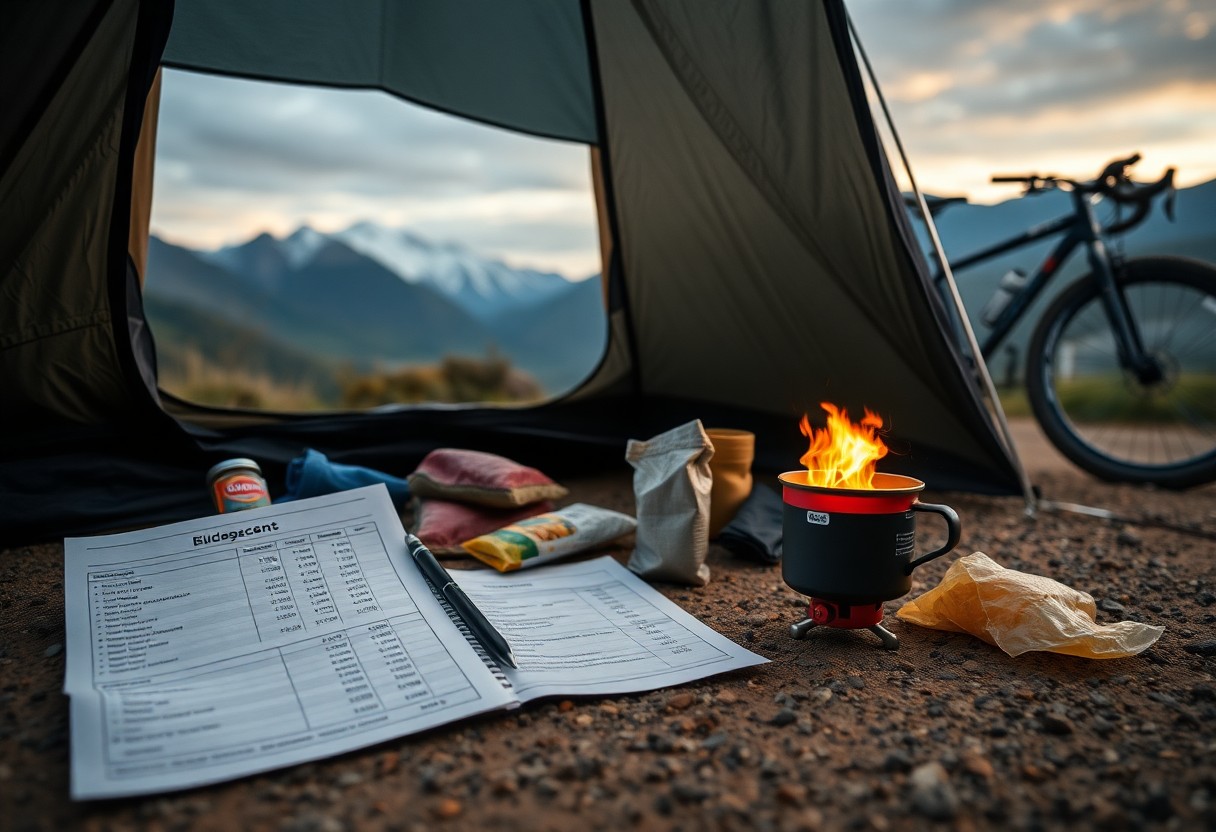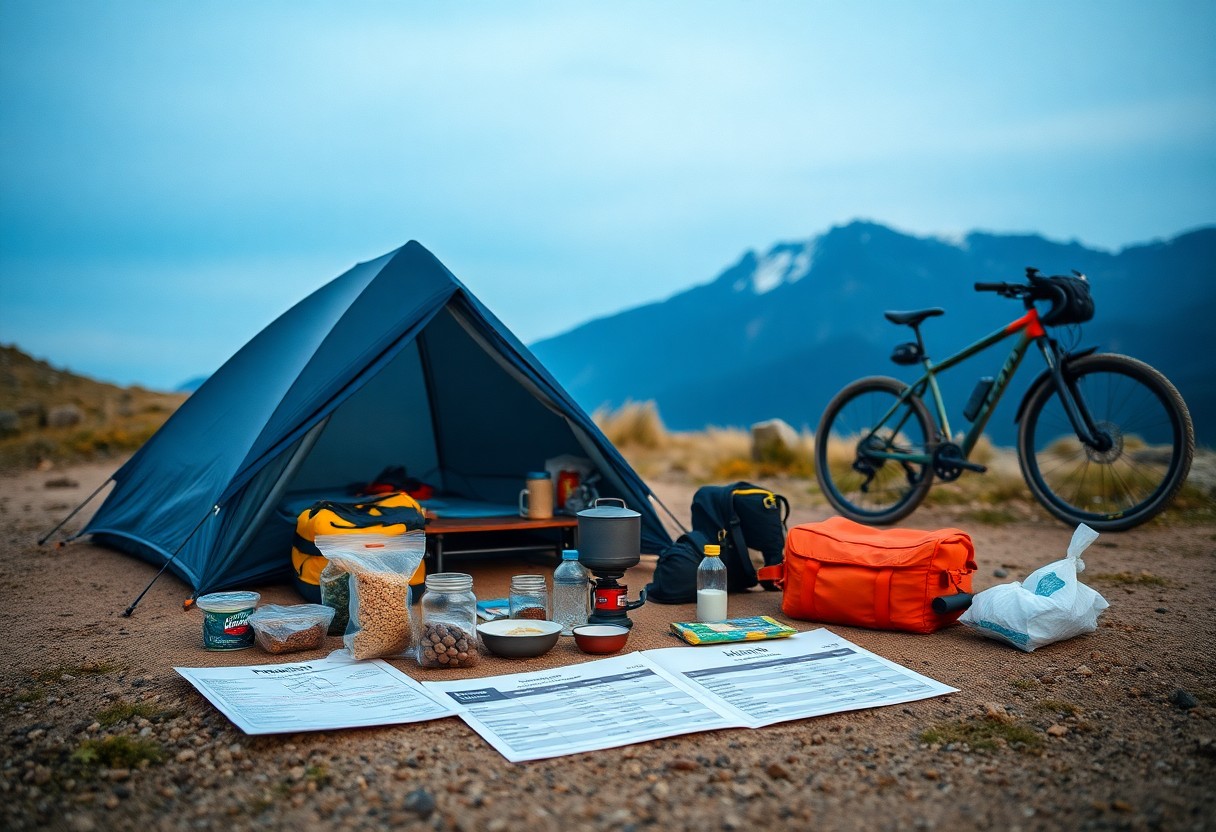Costs associated with bikepacking can often be misleading, as they vary greatly depending on your choices and preferences. To assist you in planning a successful adventure, this post outlines realistic expenses you should consider, covering gear, food, accommodation, and unexpected costs. By understanding these elements, you can better estimate your overall budget and ensure that your bikepacking experience is as enjoyable and fulfilling as possible.
Breaking Down the Essentials: The Gear You Really Need
Your bikepacking adventure hinges on the right gear, balancing what you need with what you can afford. Essential items include a reliable bike, a comfortable sleeping system, and suitable food storage, all tailored to your route and climate. While it’s tempting to splurge on the latest models and fancy accessories, you’ll find that prioritising functionality over brand names can significantly reduce costs without compromising your experience.
The Cost of a Bike: Finding Your Balance
The price of your bike can vary widely, with options ranging from £500 for a solid entry-level model to £3,500 for high-end performance bikes. Consider your riding style and the terrain you’ll encounter to strike a balance between quality and affordability. Investing in a reliable bike is vital, as it will be your lifeline out on the trails and roads.
Essential Accessories: Beyond the Basics
Beyond your bike, vital accessories play a pivotal role in your bikepacking setup. Items like bike lights, a good quality helmet, and panniers or a frame bag can enhance safety and convenience. While you might think these are optional, having the right gear can dramatically improve your comfort and security on the road, saving you time and hassle in the long run.
Exploring accessories further, consider a dependable repair kit that includes tools for unexpected punctures or minor mechanical issues. A decent sleeping bag and mat tailored to your climate can ensure restful nights, and a lightweight cooking system allows you to prepare nutritious meals on the go. Budgeting for these vitals ensures you’re not only prepared but also comfortable while you explore backroads and remote paths. Overall, a well-thought-out accessory selection can elevate your experience significantly.

The Hidden Costs of Accommodation and Food
Often overlooked, accommodation and food can significantly impact your bikepacking budget. While you might have planned for the cost of campsites or specific lodgings, expenses can quickly add up with unexpected fees, such as park entry charges, additional car parking, or even site reservation costs. Meal prices along your route can vary greatly, especially in remote areas or tourist hotspots where prices increase. Consider all these factors to create a more accurate budget for your trip.
Camping vs. Lodging: Weighing the Options
Choosing between camping and lodging involves more than just comfort; it’s about your wallet too. Camping generally offers lower nightly rates than hotels or inns, but it also requires investing in suitable gear and potential expenses like campsite fees. On the other hand, lodgings provide amenities and potentially safer shelter but often come at a premium, especially in popular tourist areas. Assess the trade-offs based on your budget, trip length, and desired experience.
Nourishment on the Trail: Budget-Friendly Choices
Eating while bikepacking doesn’t have to break the bank. Stocking up on energy-rich snacks like nuts, dried fruits, and granola bars can keep costs down while ensuring you stay fuelled for long rides. Keep an eye out for local markets where you can purchase fresh produce at lower prices compared to supermarkets. Simple cooking equipment allows you to prepare meals using affordable staples such as pasta, rice, and beans, making nutritious eating on a budget entirely feasible.
Opting for budget-friendly choices such as freeze-dried meals can also save you money while providing necessary nutrition. You might find that meals requiring minimal preparation, like instant oatmeal or couscous, are both economical and lightweight. Preparing your meals can yield significant savings, especially if you plan to camp for multiple nights. Carrying a compact stove can create options for cooking fresh ingredients, and keeping an eye on local supermarkets can yield deals on wholesome meals to replenish your energy. You’ll be surprised how little you can spend on sustenance while enjoying tasty meals on the trail.
Planning Your Route: The Financial Implications
Your route planning involves not just the thrill of adventure but also a careful consideration of your budget. Each kilometre you add can influence your accommodation, food, and even fuel costs if you’re using support vehicles. Mapping out your journey helps you uncover potential expenses tied to specific areas and local prices, thus allowing you to allocate funds more effectively throughout your trip.
The Importance of Research: Calculating Distances and Costs
Investing time in research can unveil the financial landscape of your route. By calculating distances between towns and identifying necessary stops, you can estimate costs related to accommodation and meals in each location. Regional differences in pricing highlight the importance of mapping out each leg of your journey in order to avoid overspending while on the road.
Choosing Alternative Routes: Saving Money without Sacrificing Adventure
Alternative routes often present opportunities to save significantly without sacrificing the adventure you seek. Taking less-travelled paths can lead to untouched landscapes and fewer tourist traps, often resulting in lower prices on lodging and food. Exploring rural areas can unearth unique local experiences, while also keeping costs down and expanding the scope of your journey.
Consider routes that lead through lesser-known regions or communities, as these may offer affordable camping sites and local eateries that won’t break the bank. For example, while a well-trodden national park may charge higher rates for camping, a detour through a nearby town could present a free or low-cost wild camping option. Additionally, indulging in home-cooked meals from local markets rather than dining in restaurants can keep your budget intact while enriching your experience. Overall, creativity in route planning not only enhances adventure but also ensures your finances stay in check.
The Unexpected Expenses: Gear Maintenance and Repairs
Unexpected gear maintenance and repairs can bite into your bikepacking budget more than anticipated, often cropping up at the least convenient times. Whether it’s a flat tyre, a failing gear system, or an unforeseen equipment malfunction, these costs can quickly add up. Setting aside a portion of your budget specifically for these surprises will help ensure you’re prepared for any situation, allowing you to resolve issues without derailing your trip or finances.
Preparing for Repairs: Budgeting for the Unforeseen
Allocating funds for unforeseen repairs is crucial. A good rule of thumb is to factor in around 10-15% of your total budget specifically for gear maintenance and repairs. Having this cushion lets you tackle unexpected surprises without panic, ensuring your journey remains focused on exploration rather than on logistics and costs.
Maintenance Best Practices: Keeping Costs Low on the Road
Keeping maintenance costs at bay while bikepacking hinges on a few simple best practices. Regularly checking your gear, including braking systems and tyre pressure, can prevent bigger issues down the line. Carrying basic repair tools allows you to make minor fixes on the go, rather than paying for service at pricey bike shops. Additionally, learning how to properly clean and lubricate your drivetrain can extend its life, reducing the need for early replacement.
Investing time in maintaining your bike effectively lowers your expenses significantly. For example, performing a quick inspection on your tyres before each ride not only helps prevent flats but can extend their lifespan well beyond the average. Aim for weekly maintenance routines to clean your bike, lubricate moving parts, and ensure everything is in optimal condition. Moreover, joining local cycling communities may provide access to shared tools and advice, making maintenance both easier and less costly while on the road.
The Reality of Long-Distance Bikepacking: What to Expect
Long-distance bikepacking can be an exhilarating yet challenging experience, bringing you face-to-face with both the beauty and unpredictability of nature. Expect varied terrain, from serene paths to rugged trails, which can test your endurance and navigation skills. Your physical and mental stamina will be pushed to its limits as you face fatigue, wild weather, and unforeseen obstacles. Embracing the reality of your journey is fundamental; it’s not all idyllic vistas and seamless rides. The moments of hardship often lead to remarkable stories and personal growth, making it an adventure worth undertaking.
The Impact of Weather and Distance on Your Budget
Weather can wreak havoc on your budget, with sudden storms compelling you to seek shelter or invest in specific rain gear. Additionally, the distance you plan to cover will directly affect your spending, especially on food and lodging. As you venture deeper into remote areas, prices for basic supplies may skyrocket, necessitating careful planning and flexibility. Keeping an eye on weather forecasts can help you avoid unnecessary expenses and enhance your overall experience.
Cultural Experiences vs. Financial Constraints: Striking a Balance
The allure of immersing yourself in diverse cultures can sometimes clash with limited funds during your bikepacking journey. Finding the right balance between enjoying local cuisines, attractions, and managing your budget is vital for a fulfilling experience. Allocating specific funds for cultural activities while keeping track of daily expenses can enhance your journey without leading to financial strain.
Losing yourself in local culture often requires some financial commitment, yet it brings significant returns in the form of unforgettable experiences. Eating at local markets, participating in community events, or staying with local families can deepen your understanding of the places you pass through. To take full advantage of these opportunities without overspending, consider setting aside a portion of your budget specifically for cultural experiences. This will enable you to enjoy the richness of the journey while ensuring you can sustain your adventure for the long haul. The key lies in prioritising experiences that resonate most with you, ultimately enriching your bikepacking story without derailing your financial plans.
Final Words
With these considerations, you can accurately assess your bikepacking budget and understand the actual costs involved. Knowing the expenses related to gear, food, accommodation, and transportation allows you to plan wisely and avoid surprises. By setting a realistic budget tailored to your needs and preferences, you can enjoy your bikepacking adventure without financial stress. Embrace the journey with confidence, ensuring your focus remains on the experience ahead rather than the costs behind.
